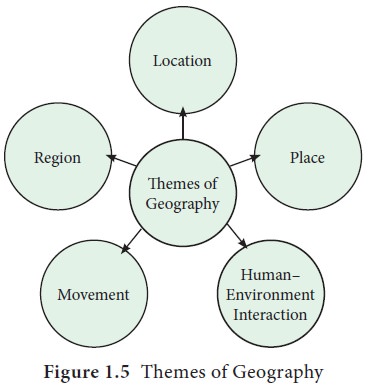Chapter: 11th Geography : Chapter 1 : Fundamentals of Geography
Five Themes of Geography
Themes
of Geography
In any subject there will be certain themes, around which the scholars work and contribute. In this way, geography subject also has certain traditional themes. Let us look at them carefully. In 1963, William D. Pattison identified the core themes of geographic studies as ‘The Four Traditions of Geography'.
These distinct, but related,
traditions, of the discipline are: Spatial tradition (areal distributions and
spatial patterns, Examples: Population movement) Area studies tradition,
(hierarchy of areas, small to large) Main-land tradition

HOTS
How
might the ship that Columbus traveled have sailed at the time when no engine
and power fuel available?
Five Themes
in Geography
Themes
of Geogra- phy are the
educational tools for understanding the geography subject in detail. It was
adopted in the year 1984 by the Association of American Geographers and these
five themes were published in the National Council for Geo-graphic
Education/Association of Ameri-can Geographers’ publication Guidelines for
Geographic Education.
Like the major traditions identified in geography,
the significant themes of the subject are also identified. The Association of
American Geographers put forward the ‘Five themes of Geography’ and it has been
widely accepted by geographers worldwide (Figure1.5). The themes are location,
place, human – environment interaction, movement and regions.
Location
Every point on earth has a location. The location
can be described in two different ways:
Absolute
location is a location as described by its latitude and
longitude on the earth. For example, the coordinates of Chennai Central Railway
station are 13°04'56" N latitude and 80°16'32" E longitude.
Relative
location is the position of a place in relation to another well-known
landmark. For example, Kallanai Dam or Grand Anicut is located roughly 350 km
south –southwest of Chennai City. The absolute and relative location related
surveys and studies fall under this category.
Place
A place is an area that is defined by everything in it. All places have features that give them personality to distinguish them from other places. A number of place names in Tamil Nadu, like Redhills, Fort St. George, Mint, and George Town are examples to this theme.
Toponym: A place name, especially one derived from
topographical feature.
Site: An area of ground on which a town, building,
or monument is constructed.
Situation: The location and surround-ings of a
place.
Human-Environment Interaction
The theme describes how people interact with the
environment and how the environment responds. These are studied with reference
to the following three key concepts:
·
Dependency:
How humans depend on the environment (Example: For water, fresh air, sunlight
etc.)
·
Adaptation:
How humans adapt to the environment (Example: Life in polar or desert regions)
·
Modification:
How humans modify the environment (Example: Construction of Underground Metro
rail, Agriculture in Israel).
Movement
Movement is the network of travel of people, goods
and ideas from one location to another. Examples: Rural-urban migration and
metro train commuting in Chennai. Air
transport which carries people and goods and the internet that allows access to ideas and knowledge across the world
are also examples of this kind.
Region
Regions are areas with distinct homogenous
characteristics such as climate (Monsoon regions), natural vegetation (Tropical
rain forests), crops (Corn Belt of USA), major landforms (Himalayan region),
industries (Chota-Nagpur plateau) etc.
Student Activity
Find the absolute location of your district.
· Find the important towns within a radius of 100 km from your residence or school along with their direction.
· Find how the name of your village or town came into existence.
· Find the total population of your town or village as per 2011 census.
· Find the altitude of your village or town from Mean Sea Level.
Related Topics